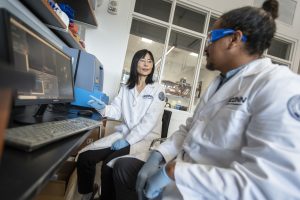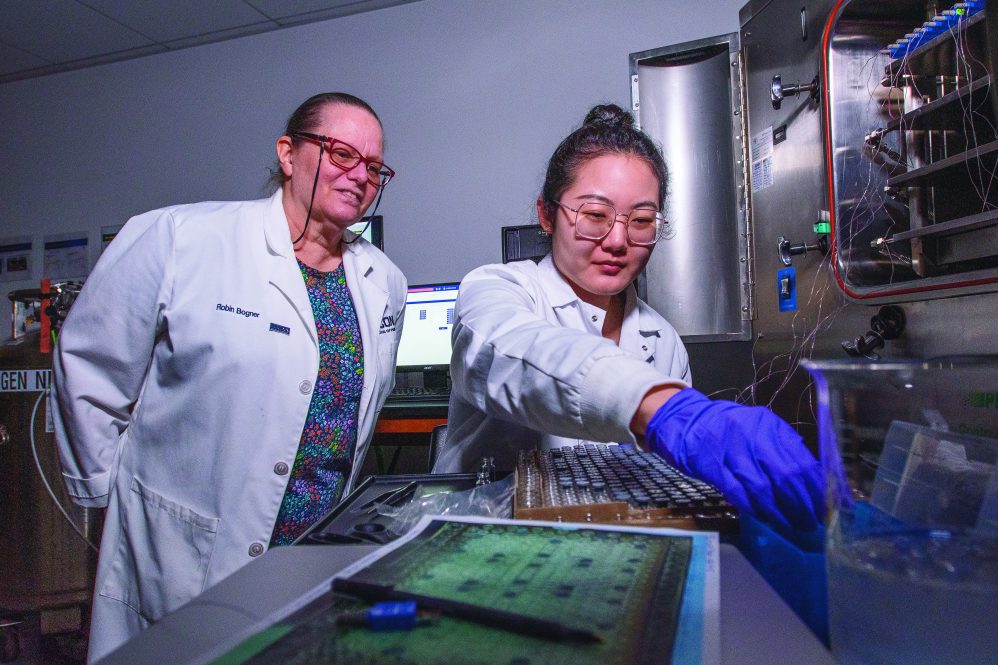As critical as the need is to produce lifesaving vaccines, the capacity to cure viruses would be impossible if not for advanced methods of drug preservation such as freeze-drying. Through innovative techniques, professors Robin Bogner and Xiuling Lu are ensuring that biopharmaceuticals remain fully potent by the time they reach patients in need.
Bogner and Lu are both faculty members of the UConn School of Pharmacy. They have helped establish UConn as a leader in research and application into freeze-drying vaccines, antibiotics, natural enzymes and antibodies.
“As leaders in pharmaceutical innovation, our UConn School of Pharmacy’s faculty expertise in freeze drying opens new and wide-ranging possibilities in drug delivery,” says Philip M Hritcko, dean of the School of Pharmacy. “By harnessing this technology, we’re not just shaping the future of medicine; we’re revolutionizing how patients receive life-changing treatments.”
From the time they are developed, vaccines have a short time before they start to lose their potency. Freeze-drying preserves the products at their strongest, allowing them to be sent wherever they are needed.

“This is a very practical way to deliver injectable products,” Lu says. “Complex products such as vaccines are freeze-dried, sent out, then reconstituted before injecting them into patients.
Pharmaceutical freeze-drying allows for long-term preservation of heat-sensitive drugs and biological materials. The process helps maintain the stability, efficacy, and quality of the products, as it avoids the use of high temperatures that can cause degradation or denaturation.
Freeze-drying consists of three main steps. In the case of vaccines, first the solutions are frozen at a very low temperature, allowing the water to solidify. Next, pressure is lowered and heat applied to induce sublimation, enabling the frozen water to evaporate into a gas without passing back through the liquid phase. Finally, remaining water molecules that remain bound to the product are removed, accomplished through further increasing temperature and lowering pressure.
However, Bogner emphasized that freeze-drying is not a simple process. For example, ice starts growing at different subzero temperatures in different vials, leading to non-uniform freezing throughout the batch. Freezing, if not under well controlled and optimized conditions, may cause products to lose their potency or compromise their quality.
The second step, sublimation, takes several days to complete, which often leads to high manufacturing cost and increased financial burden on the healthcare system. The process demands careful temperature control. If sublimation takes place at a low temperature, the process is exceedingly long and expensive. However, if the product temperature rises above a critical temperature, the product quality can be compromised.
One challenge is that each product has a different critical temperature, which is often difficult to determine. Temperature cannot be measured directly during the manufacturing process without contaminating the product going to the patient. When a batch of thousands of vials of product fails, companies can only guess at how the product temperature changed to damage the batch.
UConn is leading the research in freeze-drying techniques. Bogner’s expertise focuses on process control strategies. Meanwhile, Lu studies how the freeze-drying process affects stability of complex systems such as various types of nanoparticles, including mRNA lipid nanoparticles. Bogner and Lu have received substantial grant funding from the Department of Defense, National Institutes of Health, US Food and Drug Administration, and the Center for Pharmaceutical Processing Research. Major pharmaceutical companies are invested in their research as well.
One advancement the group is researching is non-invasive product temperature monitoring during sublimation. Other advancements are technologies for automatic control of heat input to maintain a constant optimized product temperature during sublimation and alternative heat sources to accelerate sublimation while maintaining product quality.
Bogner and Lu provide the techniques and process knowledge to the industry through short courses, presentations and publications. Their graduates are highly sought-after for positions in the pharmaceutical industry where freeze-drying expertise is in short supply.
The School of Pharmacy is carrying on a legacy of success in freeze-drying that dates back to the late Michael J.Pikal, who helped establish UConn’s reputation in the field. Bogner and Lu have built upon what Pikal established. In addition, they serve as director and associate director of the Kildsig Center for Pharmaceutical Processing Research. The Center is a research consortium with University of Minnesota and Purdue University and many industrial members established to enable advanced pharmaceutical manufacturing.
“UConn has contributed extensively, from papers to patents, to impact the industry,” Bogner says. “Dr. Pikal got it started, and we are making further advancements. We understand now how to manage the process and complex products.”
“Industry sees us as a very strong partner committed to advanced manufacturing technologies,” Bogner says. “We serve as experts to consult with and help them improve their manufacturing processes and product quality.”



